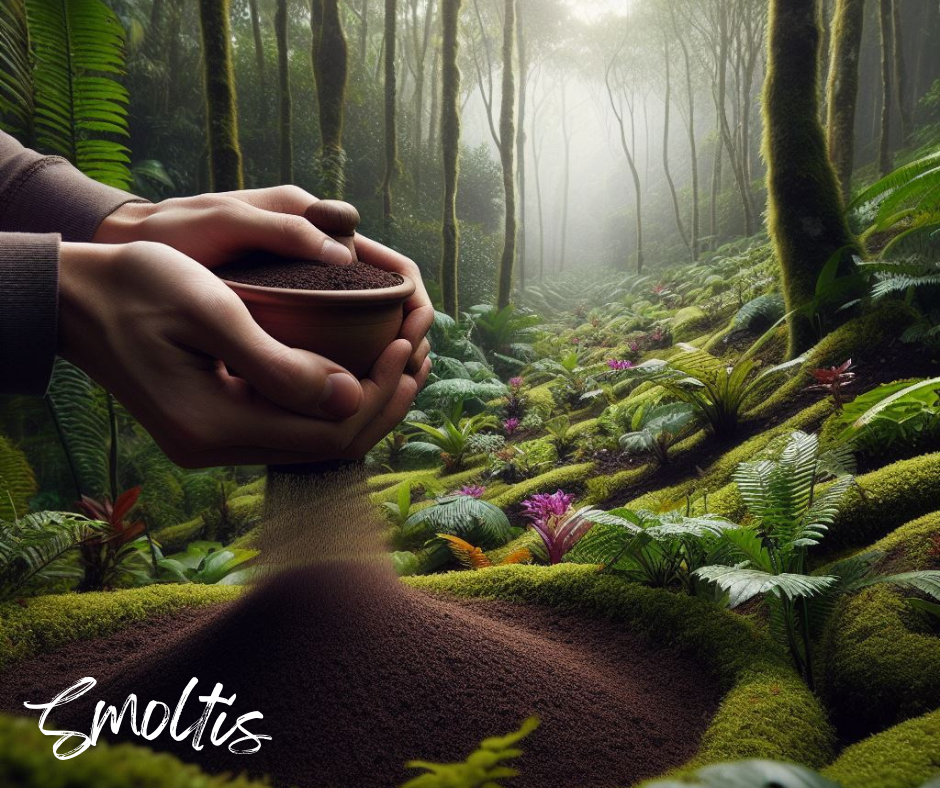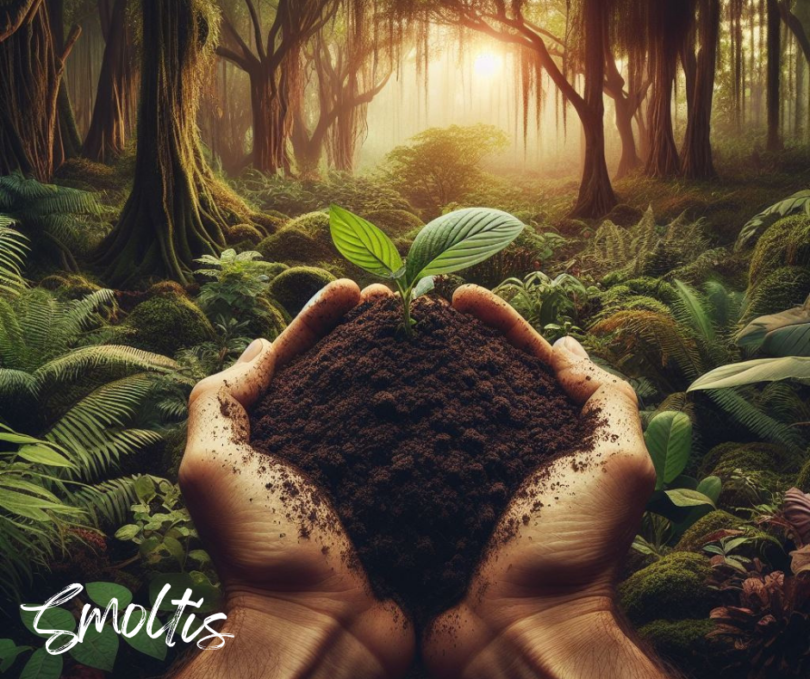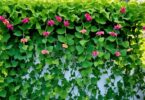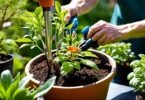Creating vibrant and thriving shaded gardens starts with understanding and improving the soil quality. Soil plays a crucial role in the success of shade-loving plants, as it provides the necessary nutrients, moisture, and structure for their growth. This section will explore the importance of soil quality in shaded gardens and the steps gardeners can take to enhance it.

Gardeners who embrace the challenges of low-light landscaping and woodland gardens know that the key to a lush, flourishing woodland understory lies in the health of the soil. By focusing on improving soil quality, they can cultivate an environment that supports the growth of shade-loving flowers, shade-loving shrubs, and shade-loving trees.
Soil quality is the foundation upon which a successful shaded garden is built. By understanding the unique soil requirements of shade-tolerant plants, gardeners can create a thriving oasis in even the most challenging low-light conditions.
Key Takeaways
- Soil quality is crucial for the success of shade-loving plants in shaded gardens.
- Improving soil fertility, structure, and pH can enhance the growth of shade-tolerant species.
- Sustainable gardening practices, such as composting and minimizing chemical inputs, can support long-term soil health.
- Understanding the unique challenges of shaded gardens, like limited sunlight and soil compaction, is the first step in developing effective soil improvement strategies.
- Incorporating organic matter, applying slow-release fertilizers, and maintaining proper drainage can significantly improve soil quality in shaded areas.
Understanding the Challenges of Shaded Gardens
Shaded gardens present unique challenges that gardeners must address to create a lush and healthy landscape. The limited sunlight availability in these areas can significantly impact plant growth, as many shade-tolerant plants require a certain amount of direct or indirect sunlight to thrive. Additionally, soil compaction and poor drainage are common issues in shaded areas, as the reduced evaporation and plant transpiration can lead to waterlogged soil conditions.
Limited Sunlight and its Impact on Plant Growth
The lack of sufficient sunlight in shaded gardens and woodland gardens can be a significant obstacle for many plants, as they rely on sunlight for photosynthesis and overall growth. This can result in stunted growth, reduced flowering, and even the demise of certain species that are not well-adapted to low-light landscaping. Understanding the specific light requirements of shade-tolerant plants is crucial when planning and designing a thriving shaded garden.
Soil Compaction and Drainage Issues
The reduced evaporation and plant transpiration in shaded areas can lead to the accumulation of excess moisture, resulting in soil compaction and poor drainage. This waterlogged soil condition can be detrimental to the health and growth of many plants, as it restricts oxygen availability and can lead to root rot and other soil-borne diseases. Addressing these challenges through proper soil management techniques is essential for creating a successful woodland understory or shaded garden.
Assessing Your Soil Quality
Before implementing any soil improvement measures, it’s crucial for gardeners to assess the current state of their soil in shaded gardens. This can be accomplished through a multi-faceted approach that combines soil testing and visual evaluation. By understanding the nutrient levels, pH, and overall health of the soil, gardeners can tailor their strategies to meet the specific needs of their shaded garden environment.
Conducting Soil Tests
Conducting a comprehensive soil test is the first step in understanding the quality of the soil in a shaded garden. These tests can provide valuable insights into the nutrient content, pH levels, and overall composition of the soil, allowing gardeners to identify any deficiencies or imbalances that may be hindering the growth of their shade-tolerant plants. Armed with this information, gardeners can then make informed decisions about the most effective soil amendments and management practices to employ.
Evaluating Soil Texture and Structure
In addition to conducting soil tests, gardeners should also visually evaluate the texture and structure of their soil in shaded areas. The soil’s physical characteristics, such as its particle size, drainage, and compaction, can greatly impact the ability of shade-loving plants to thrive. By assessing the soil’s texture, gardeners can determine its suitability for growing a diverse range of shade-tolerant plants, and take appropriate measures to improve its structure and drainage, if necessary.
Improving Soil Fertility in Shaded Areas
Enhancing the fertility of the soil in shaded gardens is a crucial step in creating a thriving and vibrant landscape. One effective approach is to incorporate organic matter into the soil. Compost and well-rotted manure can significantly improve the nutrient content and water-holding capacity of the soil, which are essential for the success of shade-loving plants.
Incorporating Organic Matter
The addition of organic matter, such as compost or well-rotted manure, can dramatically improve the fertility of shaded gardens. These organic materials not only provide a rich source of nutrients for plants but also help to improve soil structure, enhance water-holding capacity, and promote the growth of beneficial microorganisms. By incorporating organic matter into the soil, gardeners can create a more favorable environment for shade-tolerant plants to thrive.
Applying Slow-Release Fertilizers
In addition to organic matter, the use of slow-release fertilizers can be an effective strategy for maintaining soil fertility in shaded gardens. These specialized fertilizers provide a steady, gradual supply of essential nutrients to plants, ensuring that they have the resources they need to grow and flourish in the low-light conditions of shaded areas. Slow-release fertilizers can help to minimize the risk of nutrient deficiencies and support the long-term health of shade-tolerant plants.
Cultivating Healthy Soil Structure
Alongside improving soil fertility, cultivating a healthy soil structure is crucial for the success of shaded gardens. Aerating and loosening compacted soil can help improve drainage and oxygen circulation, which are vital for plant root growth. Applying a layer of organic mulch, such as wood chips or leaves, can also help retain soil moisture and suppress weed growth, creating an optimal environment for shade-tolerant plants.
Aerating and Loosening Compacted Soil
In low-light landscaping settings, such as woodland gardens and woodland understory, soil compaction is a common issue due to reduced plant transpiration and evaporation. Aerating the soil using a garden fork or specialized tool can help break up compacted layers, improving drainage and allowing for better oxygen circulation. This, in turn, promotes healthy root development and nutrient uptake for shade-loving plants.
Mulching for Moisture Retention
Applying a layer of organic mulch around shade-tolerant plants can significantly enhance soil moisture retention. The mulch acts as a protective barrier, slowing down evaporation and maintaining consistent soil moisture levels. This is particularly beneficial in shaded gardens, where the reduced sunlight and transpiration can lead to waterlogged soil conditions. By using mulch, gardeners can create a more favorable environment for shade-loving flowers, shade-loving shrubs, and shade-loving trees to thrive.
| Soil Structure Improvement Methods | Benefits |
|---|---|
| Aerating Compacted Soil | Improves drainage and oxygen circulation, promoting healthy root growth for shade-tolerant plants |
| Applying Organic Mulch | Enhances soil moisture retention, suppresses weed growth, and creates an optimal environment for shade-loving plants |
Shaded Gardens
Once the soil quality has been improved, the next step is to select the appropriate plants for your shaded garden. Choosing shade-tolerant plants that thrive in low-light conditions is essential for creating a lush and vibrant shaded garden. These shade-loving flowers, shade-loving shrubs, and shade-loving trees can transform your woodland garden or woodland understory into a captivating oasis.
Selecting Shade-Tolerant Plants
When it comes to low-light landscaping, it’s important to prioritize plants that are well-adapted to shade gardening conditions. Some excellent choices for shaded gardens include hostas, ferns, astilbes, and hellebores, which thrive in the dappled light and cooler temperatures of these environments. By carefully selecting shade-tolerant plants, you can create a visually stunning and low-maintenance shaded garden that will flourish with minimal direct sunlight.
Creating Layered Planting Beds
To maximize the use of available light in your shaded garden, consider incorporating a layered planting design. Start with taller shade-loving trees to provide a canopy, then add mid-sized shade-loving shrubs beneath them. Finally, fill in the ground layer with shade-loving flowers and other low-growing plants that can thrive in the dappled light. This layered planting approach not only creates a visually appealing, naturalistic setting but also helps to ensure that each plant receives the optimal amount of light it requires.
Maintaining Optimal Soil pH
Maintaining the optimal soil pH is crucial for the health and growth of shade-tolerant plants in shaded gardens. Different plants have varying preferences for soil acidity or alkalinity, and understanding these requirements is essential for creating a thriving shaded garden. By testing the soil pH and making adjustments through the application of lime or sulfur, gardeners can ensure that their shade-tolerant plants receive the necessary nutrients and are able to thrive in the low-light landscaping environment.
Understanding Soil Acidity and Alkalinity
The pH of the soil in shaded gardens plays a crucial role in the availability and uptake of essential nutrients for shade-loving plants. Acidic soils, with a pH below 7.0, can limit the absorption of nutrients like calcium, magnesium, and phosphorus, while alkaline soils, with a pH above 7.0, can make other nutrients, such as iron and manganese, less accessible. Gardeners must understand the specific pH requirements of their woodland garden plants to ensure optimal growth and health.
Adjusting Soil pH for Specific Plants
Once the soil pH has been tested, gardeners can make the necessary adjustments to create the ideal growing conditions for their shade-tolerant plants. For acidic soils, the addition of lime can help raise the pH and make more nutrients available to plants. Conversely, in alkaline soils, the application of sulfur can lower the pH and improve the accessibility of essential nutrients. By carefully monitoring and adjusting the soil pH, gardeners can ensure that their woodland understory plants thrive in the shaded environment.
Water Management in Shaded Areas
Proper water management is a crucial aspect of maintaining thriving shaded gardens, as the reduced evaporation and plant transpiration in these areas can lead to waterlogged soil conditions. Addressing this challenge is essential for the success of shade-tolerant plants and the overall health of your low-light landscaping.
Proper Irrigation Techniques
Implementing the right irrigation techniques is key to ensuring that your woodland gardens and woodland understory plants receive the optimal amount of moisture without oversaturating the soil. Drip irrigation systems or targeted watering methods can help deliver water directly to the root zone, minimizing water waste and preventing issues like root rot. By tailoring your watering practices to the specific needs of your shaded garden, you can create an ideal environment for your shade-loving flowers, shrubs, and trees to thrive.
Improving Drainage in Wet Shaded Areas
In areas of your shaded garden that are prone to excessive moisture, improving drainage can make a significant difference in the health and growth of your shade-tolerant plants. Solutions such as installing French drains or constructing raised beds can help alleviate waterlogged soil conditions, ensuring that the roots of your plants have access to the oxygen they need to flourish in the low-light landscaping. By addressing drainage issues, you can create a more favorable environment for your woodland garden and woodland understory plants to thrive.
Sustainable Gardening Practices
Embracing sustainable gardening practices is essential for maintaining the long-term health and vitality of shaded gardens. Gardeners can make a significant impact by adopting eco-friendly techniques that not only nourish their plants but also protect the environment.
Composting and Recycling Garden Waste
One of the cornerstones of sustainable gardening in shaded areas is the practice of composting and recycling garden waste. By turning leaves, branches, and other organic matter into nutrient-rich compost, gardeners can reduce their reliance on synthetic fertilizers and provide their shade-tolerant plants with the essential nutrients they need to thrive. This closed-loop system not only enhances soil quality but also diverts valuable resources from landfills, promoting a more circular and sustainable approach to gardening.
Minimizing Chemical Inputs
In the delicate ecosystem of a shaded garden, minimizing the use of chemical inputs, such as pesticides and herbicides, is crucial. These harsh compounds can disrupt the natural balance of the garden, harming beneficial organisms and potentially contaminating the surrounding environment. By embracing organic pest control methods and employing manual weed removal techniques, gardeners can create a more resilient and eco-friendly shaded garden that supports a diverse array of flora and fauna.
FAQ
What are the key challenges in maintaining a shaded garden?
The main challenges in shaded gardens include limited sunlight availability, which can impact plant growth, as well as soil compaction and drainage issues due to reduced evaporation and plant transpiration.
How can I assess the quality of my soil in a shaded garden?
To assess your soil quality, you can conduct soil tests to determine the nutrient levels, pH, and overall health of the soil. Additionally, evaluating the soil’s texture and structure can help you understand its suitability for growing shade-tolerant plants.
What are the best ways to improve soil fertility in a shaded garden?
Incorporating organic matter, such as compost or well-rotted manure, can significantly enhance the soil’s nutrient content and water-holding capacity. Applying slow-release fertilizers can also provide a steady supply of essential nutrients to support plant growth in low-light conditions.
How can I cultivate a healthy soil structure in my shaded garden?
Aerating and loosening compacted soil can improve drainage and oxygen circulation, which are vital for plant root growth. Applying a layer of organic mulch can also help retain soil moisture and suppress weed growth.
What are the best shade-tolerant plants for my shaded garden?
When selecting plants for your shaded garden, choose species that are known to thrive in low-light conditions, such as shade-loving flowers, shrubs, and trees. Incorporating a layered planting design can also help maximize the use of available light.
How can I maintain the optimal soil pH in my shaded garden?
Understanding the soil’s acidity or alkalinity and adjusting it accordingly is crucial for the health and growth of shade-tolerant plants. Testing the soil pH and making adjustments through the application of lime or sulfur can help ensure that your plants receive the necessary nutrients.
How do I manage water effectively in a shaded garden?
Proper irrigation techniques, such as drip systems or targeted watering, can help ensure that plants receive the right amount of moisture without oversaturating the soil. Improving drainage in wet shaded areas through the installation of French drains or raised beds can also help alleviate excessive moisture.
What sustainable gardening practices can I implement in my shaded garden?
Embracing sustainable practices like composting and recycling garden waste can provide a valuable source of organic matter, reducing the need for synthetic fertilizers and improving soil structure. Minimizing the use of chemical inputs, such as pesticides and herbicides, can also help create a more eco-friendly and resilient garden ecosystem.







